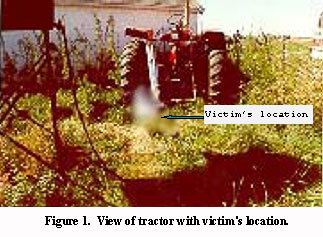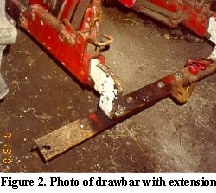Farmer Dies When He is Pinned Under Drawbar While Fueling Tractor
FACE INVESTIGATION # 00WI11301
SUMMARY:

A 91 year-old beef farmer (the victim) was pinned under the drawbar of a farm tractor after fueling the tractor while standing on a stepladder. The fuel cap was located on top of the tractor, about 65 inches high, midway from the front to the operator’s seat. The farmer’s habit was to place a 4-foot ladder on the tractor body in front of the left rear tire, climb two or three steps with the fuel pump in hand, remove the cap, fill the tank, replace the cap, and climb down the ladder. On the day of the incident, he apparently replaced the cap after adding the fuel, and fell toward the tractor wheel, striking the shift lever and throwing the tractor into a forward gear. As the tractor began to roll forward, the victim and the ladder rolled up and over the left fender and fell upside down. The victim was caught between the left rear wheel and under a drawbar attachment, while the tractor rolled forward about 6 feet until it was stopped when it struck a block wall (figure 1). The victim was found by his sister-in-law, who went to the farm to investigate when the victim did not answer phone calls for several days. She immediately called for emergency services and notified the victim’s neighbor and brother. EMS responders and the sheriff arrived within 15 minutes. The coroner was called, and pronounced the victim dead at the scene. The FACE investigator concluded that to help prevent similar occurrences, farmers should:
- shift the tractor into park, set the brakes and turn off the engine before dismounting from the tractor. For tractors without a park position, farmers should shift into neutral, set the brakes and turn off the engine before dismounting.
- seek and follow medical advice and take precautions to prevent falls if they have medical conditions that could cause loss of balance.
INTRODUCTION:
On September 21, 2000, a 91-year-old male dairy farmer was pronounced dead of injuries he received when he was pinned by a tractor wheel and drawbar at his beef farm. The Wisconsin FACE field investigator learned of the incident through the death certificate on December 22, 2000. The FACE investigator reviewed the death certificate and the coroner and sheriff reports, and interviewed family members on July 13, 2001. The farm had been sold, so a site visit was not possible.
This incident occurred at a beef farm owned and operated by the victim. He had lived on the farm all his life, and learned to operate farm machines through on-the-job experience. The victim’s brother operated a farm about ½ mile away, and the two farmers usually purchased their farm machines and tractors together. They often worked together at each other’s farms, and knew their daily routines and habits. Both of their farms had been operated for over 50 years as dairy farms, but both farmers quit dairying some years before the incident. At the time of the incident, the victim was raising about 40 beef cattle on his 160 acre farm, as well as renting out the crop fields to area farmers. He typically would work in the farmyard in the morning, take a midday break for lunch and a rest, and then drive a tractor to the field where the cattle ranged. He was considered to be a safe tractor and farm machine operator by family members and farm neighbors, and had not been seriously injured during his lifetime of farming. He had a chronic disease which could cause dizziness, and had some leg weakness and joint pain.
The victim and his brother had purchased the tractor new over 40 years ago, and usually kept it in a shed at the victim’s farm. The victim used it occasionally for tasks in the farmyard, and to travel and carry supplies to the field where the beef cattle grazed. Some years before the incident, a neighbor had attached a steel plate to the left side of the tractor drawbar to provide a step for the victim when he mounted and dismounted the tractor. The fuel tank inlet on this tractor was located on top of the tractor, about 65 inches from the ground, midway from the front to the operator’s seat. The farmer’s habit was to place a 4-foot ladder on the tractor body in front of the left rear tire, climb two or three steps with the fuel pump in hand, remove the cap, fill the tank, replace the cap, and climb down the ladder. His brother reported the victim would always turn off the engine while refueling, to prevent fire.
INVESTIGATION:

The victim was last seen alive on September 18, 2000, but it is unknown on which date the incident occurred. On the day of the incident, the tractor was situated alongside the elevated bulk fuel tank in the farmyard. The terrain in this area was flat. Either during the re-fueling process, or after it was completed, the tractor engine may have been running while he was on the ladder. At some time after the fuel tank was filled and the fuel cap replaced, he fell toward the tractor wheel, striking the shift lever and throwing the tractor into 2nd gear. As the tractor began to roll forward, the victim and the ladder rolled up over the left fender and fell upside down. The victim was caught between the left rear wheel and under the drawbar attachment (figure 2), while the tractor rolled forward about 6 feet until it was stopped when it struck a farm building. The victim was found on September 21, 2000 by his sister-in-law, who went to the farm to investigate when the victim did not answer phone calls. He was pinned head down between the wheel and drawbar attachment. The ladder was upside down behind the drawbar and next to the fender. The sister-in-law immediately called for emergency services and notified the victim’s neighbor and brother. EMS responders and the sheriff arrived within 15 minutes. The coroner was called, and pronounced the victim dead at the scene. The engine key was turned on and the throttle was in the forward position, with the engine stalled when the sheriff examined the tractor. The fuel pump was found on the ground, along with a stick the victim used to measure the level of fuel in the tank. The fuel tank was full, and the cap was in place.
CAUSE OF DEATH: The death certificate listed the cause of death as accidental asphyxiation.
Recommendations/Discussion
Recommendation #1: Farm tractor operators should shift the tractor into park, set the brakes and turn off the engine before dismounting from the tractor. For tractors without a park position, farmers should shift into neutral, set the brakes and turn off the engine before dismounting.
Discussion: Tractors may roll if parked without an effective braking device. The vibration created by a running engine may increase the possibility of initiating the rolling motion. Farm tractor operators can prevent tractors from rolling by shifting into park if possible, setting the brakes and turning off the engine before dismounting. In this case, the farmer drove the tractor alongside the bulk fuel tank, and dismounted the tractor without setting the brakes. He may also have left the engine running while he was out of the operator’s seat.
Recommendation #2: Farmers should seek and follow medical advice and take precautions to prevent falls if they have medical conditions that could cause a loss of balance.
Discussion: Some medical conditions can impair a worker’s ability to maintain balance, or stay alert and responsive to hazards. Farmers should inform their medical providers of the scope of activities they perform, and heed the advice they receive about operating machinery and climbing ladders. Technical assistance for farmers who must adapt to physical limitations is also available from agricultural engineers, state vocational rehabilitation counselors, agricultural equipment and supply manufacturers, and Extension programs that serve people with physical disabilities.
FATAL ASSESSMENT AND CONTROL EVALUATION (FACE) PROGRAM
FACE INVESTIGATION # 00WI11301
Staff members of the FACE Project of the Wisconsin Division of Health, Bureau of Public Health, do FACE investigations when a work-related fatal machine-related, youth worker or road construction work-zone death is reported. The goal of these investigations is to prevent fatal work injuries in the future by studying: the working environment, the worker, the task the worker was performing, the tools the worker was using, the energy exchange resulting in fatal injury and the role of management in controlling how these factors interact.
To contact Wisconsin State FACE program personnel regarding State-based FACE reports, please use information listed on the Contact Sheet on the NIOSH FACE web site. Please contact In-house FACE program personnel regarding In-house FACE reports and to gain assistance when State-FACE program personnel cannot be reached.
